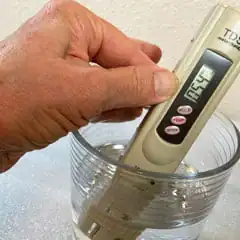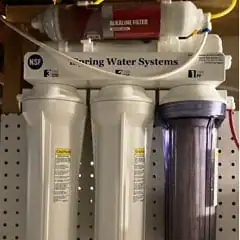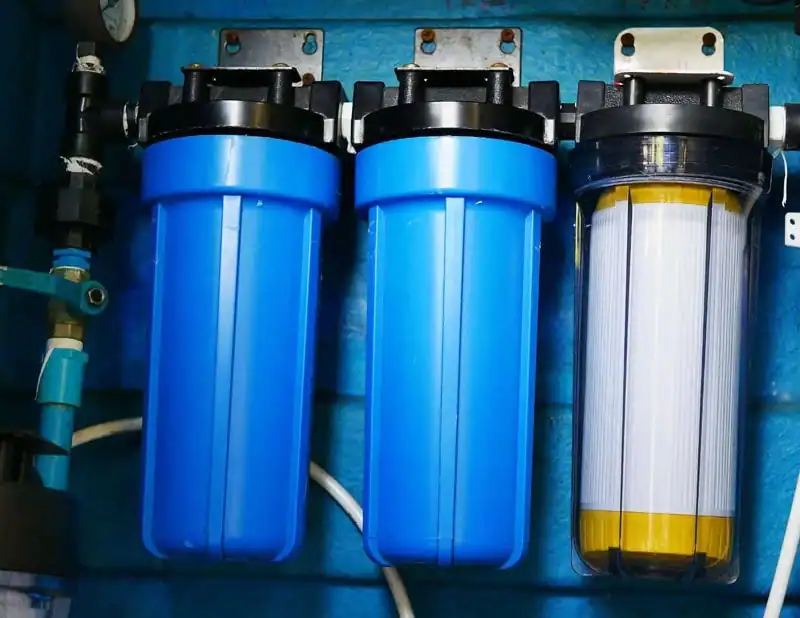Water softener system and reverse osmosis filtering are two popular methods for improving water quality. Hard water, which contains high levels of calcium and magnesium minerals, can cause damage to appliances and reduce the effectiveness of soaps.
Water softening systems and Reverse Osmosis filters can both remove these minerals, but what’s the difference? Why would you choose one system over the other? Is there a reason to use both? When deciding between a water softener and reverse osmosis system, it’s important to consider the specific needs and water quality of your household.
Water Softening Systems
A water softener works by using ion exchange to remove calcium and magnesium ions from water, replacing them with sodium ions. Our website has a number of articles about water softening systems and how they work. A starting place to learn about them is Maximizing The Benefits Of Water Softener Salt. Even though the process uses salt, the water that comes from the system does not come out salty, due to the ion exchange process.
There are a number of benefits to softening very hard water, including allowing soaps, shampoos and laundry detergents to work more efficiently. Water Softener Salt: Its Effects on Pipe Corrosion discusses water quality issues having to do not only with the pipes in your home, but also how minerals like calcium and magnesium can build up in appliances and around faucets and shower heads.
In short, water softening systems are designed to combat Hard Water – water that contains an excess of Calcium and Magnesium.

Reverse Osmosis Filtering Systems
Reverse Osmosis (RO) is a water filtration process that removes impurities and contaminants from water by using a semi-permeable membrane. Many Reverse Osmosis systems also incorporate other filtering stages such as sediment filters and carbon filters to help improve the quality and drinkability of the water.
The RO system works by applying pressure to the water, forcing it through the membrane while leaving behind the impurities. The RO membrane is highly effective at removing impurities, but it requires regular maintenance and replacement to ensure optimal performance. The process also generates a fair amount of waste water, which is directed to a drain.
Reverse Osmosis is used in households, industries, and commercial settings to purify water. Reverse Osmosis filtering is an important component used in desalinization of ocean water as described in this U.S. Geological Survey article about Desalinization.
The minerals that Reverse Osmosis removes includes Calcium and Magnesium, but its unique value is that it also removes harmful minerals such as heavy metals such as lead and arsenic, and it can also remove fluoride, nitrates and various salts.
Water Softening vs Reverse Osmosis Filtering
So why would I choose one system over the other? The choice comes down to what water quality issue you are concerned about:
Water Softening Systems – Good for making ‘soft water’. Good for removing Calcium and Magnesium. Good for improving effectiveness of soaps & detergents. Good for reducing mineral deposits on surfaces such as glass shower doors and walls.
Reverse Osmosis Filtering – Good for removing contaminants from drinking water. RO systems are often used by people who are not on a municipal water supply system: people with wells, people who live in remote locations or where city water treatment is not available (such as in the mountain west or remote ranches/farms). Good for people who live in places where the city water supplies are not always reliable. Good for crystal clear ice cubes. Good for people who just want piece of mind that their water is of the best quality possible.
Measuring Water Quality Indicators
How to Measure Water Hardness
How does someone figure out if they have hard water? There may be some telltale signs:
- White to gray ‘crust’ that forms around faucet handles or nozzles
- Spotty mineral deposits on glass shower doors or walls
- Shower heads where the holes plug up with deposits – sometimes causing the water to spray in weird directions instead of down
- Needing to use more than the recommended amount of laundry detergent or dishwasher soap to effectively clean items
- Shampoo or hand soap won’t suds up well
People who sell water softening systems are happy to provide free water hardness readings. If you’d like to just test hardness yourself, there are test strips that can give you a water hardness reading.
World Health Organization (WHO) and USGS (linked above) considers anything less than 60 ppm to be Soft. Anything more than 180 ppm is considered Very Hard. However, the Water Quality Association and water softener sales people will typically refer to anything higher than about 17ppm Slightly hard.
How to Measure Water Quality
How do you tell if your drinking water has quality problems? If you have doubts about your drinking water, GET IT TESTED!
If you think your water may be compromised: Get a water test where you can send a sample of your water to a lab for professional evaluation. If you are on a well, or there are other reasons to suspect your water quality, this is important to do for you, your family and your pets.
Lab water testing is often available from your county extension office or state water quality agency. If they don’t provide the service directly, they usually have recommendations for companies in your area that can do the testing.
If you are just curious – or you’d like to repeat the test over a period of time: There are simple to use and relatively inexpensive water test strips that will give you approximate readings of about 16 different water quality measurements, from water hardness to testing for metals like iron and copper. Some of these kits also come with some bacteria testing kits – which are great for when you are testing well water, but probably are not necessary if you are on city water. Here is a link to one of the more comprehensive choices:
These strips measure a wide range of factors that contribute to quality drinking water. The package also includes other testing supplies targeted at bacteria which is important if you are testing well water for drinking.
What About Total Dissolved Solids?
Sometimes you hear the term ‘total dissolved solids’ or TDS in relationship to discussions about hard water – what’s the difference?
Total Dissolved Solids is a measurement of ALL the solids that are present in your water. This includes everything both organic and inorganic that is dissolved in your water. It does include Calcium and Magnesium, but it also includes all other possible minerals, metals, nitrates and other contaminants in Parts Per Million (PPM). A ‘water hardness’ reading also is given in Parts Per Million, but it only includes the Calcium and Magnesium.

I have a meter that measures Total Dissolved Solids. I use it to test when the membrane in my Reverse Osmosis filtering system needs to be replaced.
Here I am measuring the total dissolved solids for the water that comes from my city municipal water supply. 54ppm is very low! Since my TDS includes all solids, my water hardness is either equal to, or probably lower than 54ppm.
What Does Reverse Osmosis Filter Water Taste Like?
This is a subjective topic. Most people like the taste of RO filtered water, but some people like the taste of the tap water they are used to. My daughter is one of those who likes tap water, even though I’ve had Reverse Osmosis filtered water available right at the kitchen sink since before she was born.
Reverse Osmosis water, in my opinion, has a less chemical taste and smell than tap water. There is also absolutely no variation in the flavor over time. In my first system, installed about 35 years ago, the flavor was a little ‘flat’ because I had a four stage system: sediment, pre-carbon, reverse osmosis membrane, and post-carbon stages. Since then, filtering systems have become available that post-process the water with components that improve the flavor, such as an alkaline cartridge that adds back calcium and magnesium (bad for appliances but good for flavor!). The carbon pre- and post-processing stages have become more sophisticated.

This is my current Reverse Osmosis system that I’ve been using for the last two years. The water flavor is comparable to bottled purified water. It also is connected to my freezer’s ice maker. I will link the system below if you’d like to check out the details.
This link will take you to the 6 stage Reverse Osmosis filtering system I use. This system is made by iSpring, a manufacturer in the U.S. that I've been buying systems and filter replacements from for a long time, and who I know to have good customer service. ( I apologize: Amazon is not supplying the image and price on this item for some reason. )
Other Uses for Reverse Osmosis Filtered Water
Aquariums
The primary use I am aware of for RO water beyond drinking it is to use it for fish aquariums. Consistently using water that does not contain phosphates, nitrates, nitrites or chlorine goes a very long way toward being able to keep your fish healthy and to reduce the factors that promote algae growth.
I talk about saltwater aquarium issues in Aquarium Salt Safety: The Truth About Using Water Softener Salt, and Reverse Osmosis water is mentioned there. I kept several saltwater aquariums over a period of about 20 years, so I have plans to add some more saltwater information at some point, so will link them here when I do. Suffice it to say that Reverse Osmosis filtered water will improve your aquarium success whether you are running saltwater (fish, live rock, invertebrates, coral) or tropical aquariums (fish, live plants).
Coffee!
Always using Reverse Osmosis water will improve the flavor of your coffee. Okay – once again it’s my opinion, but I am firm in it! Using water with dramatically reduced Total Dissolved Solids (TDS) will also reduce the frequency of needing to descale your espresso machine. For other commentary and tips to improve the flavor of your coffee, be sure to check out Coffee Conundrum: Does Salt Really Take The Bite Out of Bitter Beans.
Can You Use Reverse Osmosis with a Water Softener?
A water softener is usually the best solution to prevent scale buildup and minerals in the water, aka Hard Water. However, if you have other contaminants in your water, such as lead, arsenic, or nitrates, a reverse osmosis system may be necessary to keep your drinking water safe.
One option is to install both a water softener and a reverse osmosis system. In this case, the water softener would be installed first to remove the hard minerals, and then the water would go through the reverse osmosis system to remove any remaining impurities. This can be a good solution if you have very hard water or if you are concerned about the quality of your drinking water.
Another option is to use a water softener with a built-in reverse osmosis system. Some water softeners are designed to include a reverse osmosis system, which can be a convenient and cost-effective solution if you need both types of systems. However, these systems can be more expensive and may require more maintenance than a standalone water softener or reverse osmosis system.
The third route, and the one I would pick would be to get the supply water for the Reverse Osmosis filter prior to the water softener system. That way I am processing my drinking water once with the RO filtering and I am processing the rest of the household water through the water softener. I would also note that any outside water (such as irrigation or garden hose water) should also be upstream of the water softener. Use a bucket of indoor household water if you are washing your car ;)
Reverse Osmosis Filtering Stages
Typical Reverse Osmosis (RO) systems tend to involve a series of filters that remove particles and contaminants from the water in stages before it reaches the semi-permeable membrane. This tends to improve the effectiveness of the system and preserves the Reverse Osmosis membrane so that it doesn’t have to be replaced as often. The most basic (most inexpensive) systems have these filtering stages:
- The first filter is usually a sediment filter that removes larger particles such as sand, silt, and dirt.
- The second filter is a carbon filter that removes chlorine, pesticides, and other chemicals.
- The third filter is a reverse osmosis membrane that removes dissolved solids, such as salt and minerals.
The purified water is collected and stored in a tank for use. The tank is slightly pressurized so that it will deliver the water to a special faucet at your kitchen sink or to supply the ice maker in your freezer.
Some newer Reverse Osmosis systems also add filtering stages to increase the alkalinity of the purified water adding back in some Calcium and Magnesium to improve the flavor of the purified water. Other refinements are carbon filters for both pre- and post-processing the water, and carbon based filtering that remove odor causing elements like sulfur.








